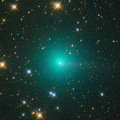
|
It brightened up to 6.7 mag in June (June 9, Marco Goiato). Now it is fading, but still bright as 8.1 mag (July 1, Marco Goiato). In the Northern Hemisphere, it is observable until mid August in the evening low sky. In the Southern Hemisphere, it will be getting lower after this, and will be too low to observe in late August.
Date(TT) R.A. (2000) Decl. Delta r Elong. m1 Best Time(A, h)
July 4 12 39.40 -15 19.9 1.437 1.804 93 7.8 21:03 ( 51, 22)
July 11 12 36.18 -10 44.7 1.613 1.813 83 8.1 20:59 ( 60, 21)
|
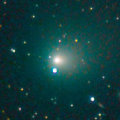
|
Now it is so bright as 8.6 mag (July 3, Juan Jose Gonzalez). It will be observable at 8-10 mag in good condition for a long time until late autumn.
Date(TT) R.A. (2000) Decl. Delta r Elong. m1 Best Time(A, h)
July 4 22 0.34 34 38.4 2.671 3.126 107 8.3 3:05 (279, 88)
July 11 21 46.21 33 43.3 2.567 3.126 114 8.2 2:32 ( 0, 89)
|
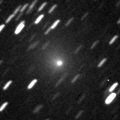
|
Now it is so bright as 8.6 mag (June 18, Marco Goiato). It will never be observable again in the Northern Hemisphere. In the Southern Hemisphere, it keeps observable for a long time after this in the evening sky.
Date(TT) R.A. (2000) Decl. Delta r Elong. m1 Best Time(A, h)
July 4 8 32.02 -11 4.8 1.802 1.245 41 8.5 21:03 ( 92,-23)
July 11 8 49.62 -15 33.7 1.807 1.278 43 8.7 20:59 ( 89,-27)
|
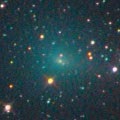
|
Now it is very bright as 9.3 mag (June 19, Marco Goiato). It will be bright at 9-10 mag for a long time until autumn.
Date(TT) R.A. (2000) Decl. Delta r Elong. m1 Best Time(A, h)
July 4 22 45.64 -9 2.6 0.836 1.627 122 9.3 3:05 (342, 44)
July 11 22 52.22 -9 8.5 0.813 1.645 127 9.4 3:10 (351, 45)
|
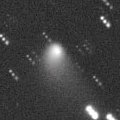
|
Now it is very bright as 9.8 mag (June 13, Marco Goiato). It keeps as bright as 10-11 mag for a long time untio 2010 spring. It is not observable in the Northern Hemisphere now. But it will appear in the morning sky in early October, then it keeps observable at 10 mag in good condition for a long time. In the Southern Hemisphere, it will be unobservable soon.
Date(TT) R.A. (2000) Decl. Delta r Elong. m1 Best Time(A, h)
July 4 8 2.55 -2 58.4 3.314 2.498 31 10.2 21:03 (104,-24)
July 11 8 15.16 -1 49.8 3.324 2.465 27 10.1 20:59 (107,-26)
|
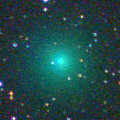
|
It was bright as 8-9 mag in April and May. Now it is not observable. But it will appear in the morning sky again at 12 mag in late August, then it will be fading slowly in the low sky. In the Southern Hemisphere, it keeps observable in good condition for a long time after August.
Date(TT) R.A. (2000) Decl. Delta r Elong. m1 Best Time(A, h)
July 4 6 43.59 23 50.1 2.553 1.537 2 10.4 3:05 (224,-16)
July 11 6 54.52 20 52.9 2.603 1.596 6 10.6 3:10 (230,-15)
|
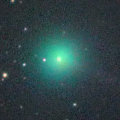
|
It has been observed bright as 8-9 mag from April to June. Now it is fading, but still bright as 10.2 mag (June 28, Marco Goiato). In the Southern Hemisphere, it keeps observable in a good condition for a long time. In the Northern Hemisphere, it will never be observable again.
Date(TT) R.A. (2000) Decl. Delta r Elong. m1 Best Time(A, h)
July 4 7 20.06 -59 28.7 1.452 1.662 82 10.5 21:03 ( 37,-48)
July 11 8 0.47 -57 26.7 1.596 1.737 80 10.9 20:59 ( 41,-47)
|

|
It reaches up to 11 mag in summer. However, the condition of this apparition is worst. We can not observe it at all.
Date(TT) R.A. (2000) Decl. Delta r Elong. m1 Best Time(A, h)
July 4 6 57.50 25 30.2 2.318 1.304 2 13.0 21:03 (137,-15)
July 11 7 25.19 25 18.9 2.287 1.274 3 12.5 20:59 (136,-15)
|

|
Now it is very bright as 11.1 mag (June 14, Marco Goiato). It will be too low to observe in the evening sky in July.
Date(TT) R.A. (2000) Decl. Delta r Elong. m1 Best Time(A, h)
July 4 11 4.83 6 36.7 2.447 2.178 62 12.9 21:03 ( 85, 18)
July 11 11 16.91 5 10.8 2.510 2.176 59 13.0 20:59 ( 85, 15)
|
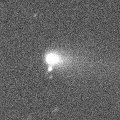
|
It has already brightened up to 13.1 mag (July 3, Juan Jose Gonzalez). It will brighten rapidly after this, and will be observable at 10-11 mag in a good condition for a long time from summer to winter.
Date(TT) R.A. (2000) Decl. Delta r Elong. m1 Best Time(A, h)
July 4 0 1.31 -4 33.1 0.871 1.486 103 13.5 3:05 (316, 40)
July 11 0 26.97 -3 59.7 0.802 1.439 104 13.1 3:10 (318, 42)
|
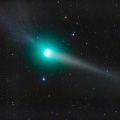
|
It passed near by the earth in late February, and it reached up to 4.9 mag (Feb. 23, Juan Jose Gonzalez). It has faded down to 11.8 mag (May 17, Carlos Labordena), and became unobservable. But it will appear in the morning sky again at 14 mag in August.
Date(TT) R.A. (2000) Decl. Delta r Elong. m1 Best Time(A, h)
July 4 7 1.83 21 43.3 3.749 2.733 2 13.2 21:03 (134,-18)
July 11 7 5.08 21 36.8 3.824 2.810 3 13.3 3:10 (228,-16)
|
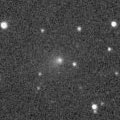
|
It is already bright as 13.2 mag and visible visually (June 17, Juan Jose Gonzalez). It will be brightening rapidly after this, and will be 10 mag in autumn. It keeps observable for a long time until 2010 February. But in the Northern Hemisphere, it will be lower than 20 degree after August, then it keeps very low all through the brightest time. It locates a bit higher in the Southern Hemisphere.
Date(TT) R.A. (2000) Decl. Delta r Elong. m1 Best Time(A, h)
July 4 12 42.11 -3 33.0 1.416 1.730 89 13.4 21:03 ( 59, 31)
July 11 12 51.08 -4 52.0 1.440 1.688 84 13.2 20:59 ( 61, 27)
|

|
Now appearing in the morning sky. It was observed at 13.9 mag, as bright as expected (June 26, Ken-ichi Kadota). It will be getting higher gradually while fading slowly after this.
Date(TT) R.A. (2000) Decl. Delta r Elong. m1 Best Time(A, h)
July 4 4 45.01 27 38.5 2.196 1.398 29 13.4 3:05 (240, 6)
July 11 5 10.77 28 5.0 2.201 1.415 29 13.5 3:10 (241, 7)
|
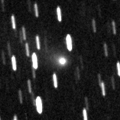
|
New bright periodic comet. Now it is 12.9 mag and visible visually (June 17, Juan Jose Gonzalez). Moving northwards in the Milky Way. In the Northern Hemisphere, the condition becomes good after this. But the comet will fade out rapidly. It will be fainter than 15 mag in August, and fainter than 18 mag in October.
Date(TT) R.A. (2000) Decl. Delta r Elong. m1 Best Time(A, h)
July 4 18 23.24 -1 54.2 0.398 1.393 157 13.4 23:32 ( 0, 53)
July 11 18 25.60 0 50.1 0.441 1.425 153 13.8 23:07 ( 0, 56)
|
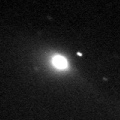
|
It brightened very rapidly, faster than expected, and reached up to 9.3 mag in spring (Mar. 26, Juan Jose Gonzalez). However, it will never be observable again in this apparition.
Date(TT) R.A. (2000) Decl. Delta r Elong. m1 Best Time(A, h)
July 4 9 0.04 22 8.2 2.722 1.903 29 13.7 21:03 (115, 2)
July 11 9 17.40 20 51.3 2.807 1.957 27 14.0 20:59 (115, 0)
|

|
It brightened up to 9.8 mag in winter (Dec. 28, Juan Jose Gonzalez). It faded down to 12.5 mag in May (May 26, Juan Jose Gonzalez), and became unobservable. Now it is not observable, however, it will be observable in good condition again in winter at 15 mag. Then it may be still visible visually.
Date(TT) R.A. (2000) Decl. Delta r Elong. m1 Best Time(A, h)
July 4 8 33.66 22 22.9 4.816 3.903 23 13.9 21:03 (119, -2)
July 11 8 41.76 21 27.8 4.906 3.957 18 14.0 20:59 (121, -6)
|
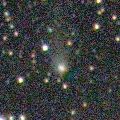
|
It brightened up to 11.5 mag in last summer (Aug. 4, Marco Goiato). Although it is not observable in the Northern Hemisphere, it keeps observable in good condition for a long time in the Southern Hemisphere. However, no visual observations have been reported since last summer. Recent CCD observations suggest that it is still visible visually around 13-14 mag.
Date(TT) R.A. (2000) Decl. Delta r Elong. m1 Best Time(A, h)
July 4 5 55.87 -38 19.1 3.898 3.547 62 14.0 3:05 (292,-43)
July 11 6 3.06 -37 47.9 3.944 3.593 62 14.0 3:10 (294,-38)
|

|
Now it is not observable. It will appear in the morning sky in September.
Date(TT) R.A. (2000) Decl. Delta r Elong. m1 Best Time(A, h)
July 4 8 28.05 19 45.6 7.070 6.143 22 14.2 21:03 (118, -5)
July 11 8 33.27 19 23.0 7.109 6.144 17 14.2 20:59 (121, -9)
|

|
Now it is 12.7 mag and visible visually (June 20, Juan Jose Gonzalez). It will be getting lower in the evening sky, and will be too low to observe in August. It will brighten up to 12-13 mag in 2010 summer.
Date(TT) R.A. (2000) Decl. Delta r Elong. m1 Best Time(A, h)
July 4 12 12.81 6 54.8 2.857 2.831 78 14.5 21:03 ( 74, 32)
July 11 12 19.02 5 47.1 2.926 2.811 73 14.5 20:59 ( 76, 28)
|
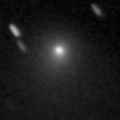
|
It reached to 10.9 mag in 2008 spring (May 11, Marco Goiato). It is fading slowly. Now it is 13.4 mag (June 1, Juan Jose Gonzalez), still visible visually. It keeps bright as 13-14 mag for a long time after this until summer.
Date(TT) R.A. (2000) Decl. Delta r Elong. m1 Best Time(A, h)
July 4 16 6.03 37 4.4 4.097 4.521 108 15.0 21:15 (180, 88)
July 11 16 4.23 36 37.1 4.199 4.571 105 15.1 20:59 (121, 87)
|
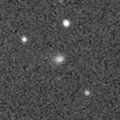
|
It has brightened up to 14 mag in outburst in 2008 August. Now it is bright as 15.4 mag (May 8, Ken-ichi Kadota), brighter than originally expected.
Date(TT) R.A. (2000) Decl. Delta r Elong. m1 Best Time(A, h)
July 4 21 26.60 -34 30.2 2.111 2.998 144 15.0 2:39 ( 0, 21)
July 11 21 24.93 -35 51.6 2.085 3.008 149 15.1 2:10 ( 0, 19)
|
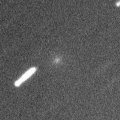
|
Now it is bright as 14.0 mag and visible visually (June 11, Juan Jose Gonzalez). However, it will be getting lower very rapidly in the evening sky, and will be too low to observe in early August. It was discovered in May, but it must have been bright and observable in the northern sky since winter.
Date(TT) R.A. (2000) Decl. Delta r Elong. m1 Best Time(A, h)
July 4 10 13.65 28 44.3 2.098 1.561 45 15.0 21:03 (111, 20)
July 11 10 34.06 24 56.0 2.139 1.576 44 15.1 20:59 (108, 17)
|
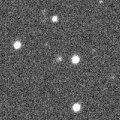
|
Now it is 16.1 mag (May 25, Ken-ichi Kadota). It will brighten up to 15 mag in 2009 and 2010, and will be observable for a long time in good condition.
Date(TT) R.A. (2000) Decl. Delta r Elong. m1 Best Time(A, h)
July 4 19 13.99 59 33.8 2.602 2.914 97 15.2 0:28 (180, 65)
July 11 18 36.40 59 56.9 2.581 2.893 97 15.2 23:14 (180, 65)
|
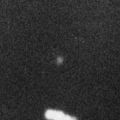
|
Now it is 15.2 mag (June 11, Artyom Novichonok). It keeps observable in good condition at 15 mag until late autumn.
Date(TT) R.A. (2000) Decl. Delta r Elong. m1 Best Time(A, h)
July 4 0 48.88 13 36.2 3.845 3.900 85 15.3 3:05 (287, 45)
July 11 0 49.06 15 9.3 3.736 3.898 91 15.3 3:10 (292, 52)
|

|
Now it is 13.7 mag (June 1, Juan Jose Gonzalez). It had been bright and visible visually around 13 mag from spring to autumn in 2008. It will be visible visually at 14 mag again until summer.
Date(TT) R.A. (2000) Decl. Delta r Elong. m1 Best Time(A, h)
July 4 13 10.05 36 2.4 6.873 6.773 80 15.4 21:03 (104, 57)
July 11 13 7.66 35 31.0 6.996 6.800 74 15.4 20:59 (105, 52)
|
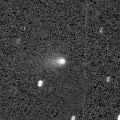
|
Now it is visible visually at 13.6 mag (Apr. 23, Mitsunori Tsumura). It will keep 14-15 mag for a while. But it will be getting lower rapidly after this, and will be too low to observe in July.
Date(TT) R.A. (2000) Decl. Delta r Elong. m1 Best Time(A, h)
July 4 12 0.94 -7 12.4 2.238 2.310 81 15.5 21:03 ( 64, 21)
July 11 12 8.87 -8 48.9 2.317 2.310 76 15.6 20:59 ( 66, 17)
|
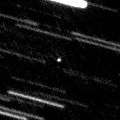
|
It passes the perihelion in June, and brightens up to 13.5 mag. But it is not observable, too close to the sun. In July, it will be observable in the morning low sky.
Date(TT) R.A. (2000) Decl. Delta r Elong. m1 Best Time(A, h)
July 4 4 51.69 33 44.9 0.947 0.489 28 15.6 3:05 (234, 8)
July 11 4 41.19 36 10.4 1.031 0.655 37 15.9 3:10 (237, 17)
|
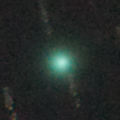
|
It brightened rapidly, and it reached up to 7.5 mag on Apr. 5 (Juan Jose Gonzalez). It is fading now. Extremely diffuse, and it is still very bright as 10.8 mag visually (June 21, Juan Jose Gonzalez). It will be visible visually for some more time with an excellent sky condition.
Date(TT) R.A. (2000) Decl. Delta r Elong. m1 Best Time(A, h)
July 4 21 0.16 19 13.8 0.924 1.742 127 15.8 2:14 ( 0, 74)
July 11 20 18.95 13 36.5 0.936 1.844 141 16.3 1:06 ( 0, 69)
|
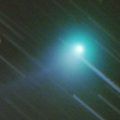
|
It reached to 6.3 mag in 2008 September in the southern sky (Sept. 4, Marco Goiato). Now it is fading. It has already faded down to 16.2 mag (May 8, Ken-ichi Kadota). It keeps observable in the northern sky while fading gradually. In the Southern Hemisphere, it will never be observable again.
Date(TT) R.A. (2000) Decl. Delta r Elong. m1 Best Time(A, h)
July 4 4 49.80 84 8.4 4.264 3.893 62 16.0 3:05 (187, 33)
July 11 5 51.23 84 24.7 4.328 3.966 62 16.2 3:10 (186, 33)
|

|
Now it is 16.7 mag (May 19, Ken-ichi Kadota), brightening as expected. It will reach up to 12 mag in 2012, and will be observable visually at 12-13 mag for a long time from 2011 to 2013. In 2009, it is observable in good condition at 16 mag from summer to autumn. In the Northern Hemisphere, the comet will be low around its brightest seasons.
Date(TT) R.A. (2000) Decl. Delta r Elong. m1 Best Time(A, h)
July 4 22 49.42 6 11.1 8.414 8.894 115 16.1 3:05 (332, 58)
July 11 22 46.61 6 6.8 8.272 8.857 122 16.1 3:10 (349, 61)
|
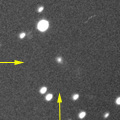
|
Now it is 16.4 mag (June 12, Ken-ichi Kadota). It will reach to 15 mag in 2010. It keeps observable for a long time after this in the Northern Hemisphere.
Date(TT) R.A. (2000) Decl. Delta r Elong. m1 Best Time(A, h)
July 4 15 4.89 7 37.9 5.233 5.761 116 16.7 21:03 ( 25, 60)
July 11 15 3.91 7 51.8 5.295 5.728 110 16.7 20:59 ( 36, 58)
|
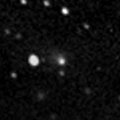
|
It brightened up to 15-16 mag in 2008 summer. Now appearing in the morning sky again. It keeps observable at 17 mag in good condition for a long time from summer to winter.
Date(TT) R.A. (2000) Decl. Delta r Elong. m1 Best Time(A, h)
July 4 2 48.63 22 43.3 3.383 2.933 55 17.0 3:05 (259, 25)
July 11 2 57.67 23 46.6 3.318 2.945 60 17.0 3:10 (261, 31)
|
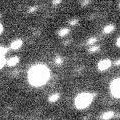
|
Now it is 17.4 mag (June 16, P. Kocher). It will be observable at 17 mag in 2009 summer and 2010 summer.
Date(TT) R.A. (2000) Decl. Delta r Elong. m1 Best Time(A, h)
July 4 17 34.50 -12 5.0 1.855 2.826 158 17.4 22:43 ( 0, 43)
July 11 17 29.80 -11 49.9 1.868 2.804 151 17.3 22:11 ( 0, 43)
|
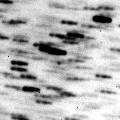
|
Now it is 17.0 mag (June 17, Charles Bell). The condition is good in this apparition. It will approach to the earth down to 0.38 A.U., and will be observable in good condition at 16.5 mag in November. It keeps observable until that time after this. But it locates somewhat low in the Northern Hemisphere.
Date(TT) R.A. (2000) Decl. Delta r Elong. m1 Best Time(A, h)
July 4 16 26.55 -21 59.5 0.735 1.679 146 17.4 21:35 ( 0, 33)
July 11 16 16.78 -21 14.9 0.719 1.620 137 17.5 20:59 ( 0, 34)
|
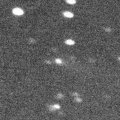
|
It was observed at 17.5 mag in 2008 summer. It is also observable at 17.5 mag in 2009 autumn. In the Northern Hemisphere, it located somewhat low in 2008, but it becomes observable in good condition in 2009.
Date(TT) R.A. (2000) Decl. Delta r Elong. m1 Best Time(A, h)
July 4 1 0.40 12 47.4 3.796 3.812 83 17.9 3:05 (286, 42)
July 11 1 4.06 13 28.8 3.697 3.814 88 17.9 3:10 (291, 48)
|
|
![]()
 116P/Wild 4
116P/Wild 4 217P/2009 F3 ( LINEAR )
217P/2009 F3 ( LINEAR ) C/2007 N3 ( Lulin )
C/2007 N3 ( Lulin ) 88P/Howell
88P/Howell 64P/Swift-Gehrels
64P/Swift-Gehrels P/2009 L2 ( Yang-Gao )
P/2009 L2 ( Yang-Gao ) 67P/Churyumov-Gerasimenko
67P/Churyumov-Gerasimenko C/2006 OF2 ( Broughton )
C/2006 OF2 ( Broughton ) C/2007 G1 ( LINEAR )
C/2007 G1 ( LINEAR ) 29P/Schwassmann-Wachmann 1
29P/Schwassmann-Wachmann 1 65P/Gunn
65P/Gunn C/2006 Q1 ( McNaught )
C/2006 Q1 ( McNaught ) 199P/2008 G2 ( Shoemaker 4 )
199P/2008 G2 ( Shoemaker 4 ) C/2009 K4 ( Gibbs )
C/2009 K4 ( Gibbs ) C/2008 N1 ( Holmes )
C/2008 N1 ( Holmes ) C/2008 P1 ( Garradd )
C/2008 P1 ( Garradd ) C/2005 L3 ( McNaught )
C/2005 L3 ( McNaught ) 77P/Longmore
77P/Longmore (3200) Phaethon
(3200) Phaethon C/2009 E1 ( Itagaki )
C/2009 E1 ( Itagaki ) C/2008 A1 ( McNaught )
C/2008 A1 ( McNaught ) C/2006 S3 ( LONEOS )
C/2006 S3 ( LONEOS ) C/2008 FK75 ( Lemmon-Siding Spring )
C/2008 FK75 ( Lemmon-Siding Spring ) 47P/Ashbrook-Jackson
47P/Ashbrook-Jackson 219P/2009 H1 ( LINEAR )
219P/2009 H1 ( LINEAR ) 107P/(4015) Wilson-Harrington
107P/(4015) Wilson-Harrington P/2008 O2 ( McNaught )
P/2008 O2 ( McNaught )![]()































